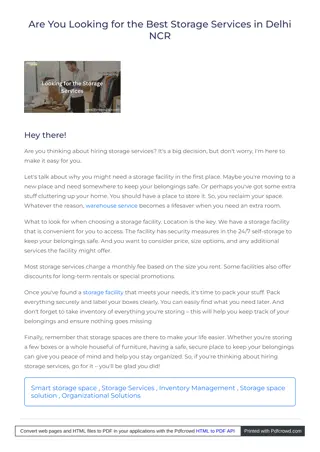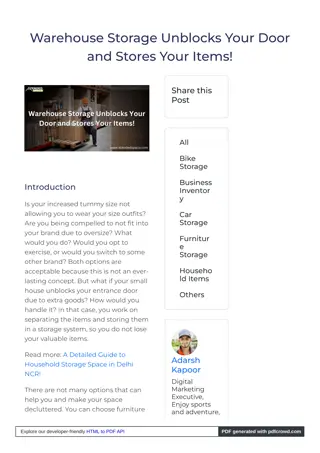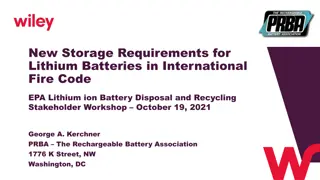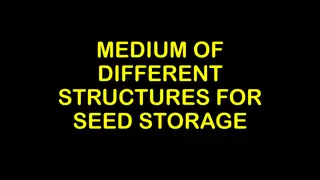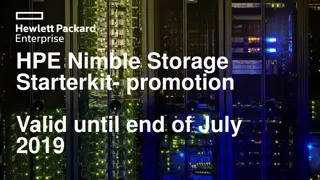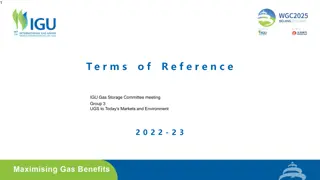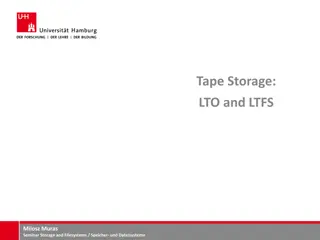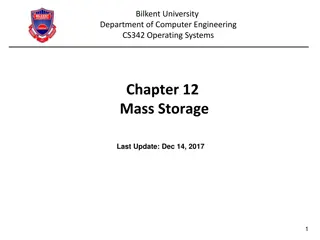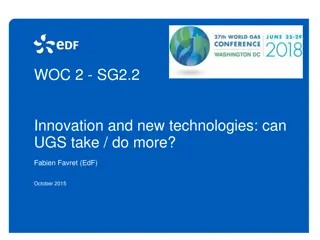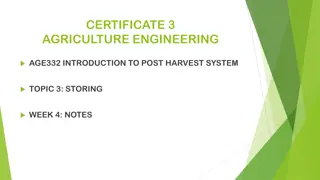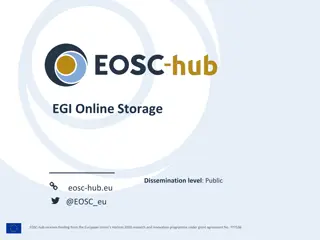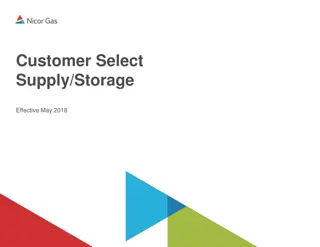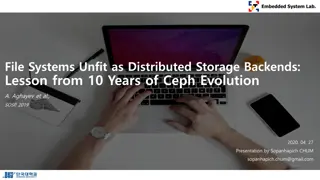
Advanced AWS S3 Security Practices
Learn about securing AWS S3 buckets, including permissions management, encryption options, and best practices for preventing common vulnerabilities like open buckets. Understand server-side and client-side encryption methods to protect data both at rest and in transit. Gain insights into managing object ownership and enhancing data protection within Amazon S3.
Download Presentation

Please find below an Image/Link to download the presentation.
The content on the website is provided AS IS for your information and personal use only. It may not be sold, licensed, or shared on other websites without obtaining consent from the author. If you encounter any issues during the download, it is possible that the publisher has removed the file from their server.
You are allowed to download the files provided on this website for personal or commercial use, subject to the condition that they are used lawfully. All files are the property of their respective owners.
The content on the website is provided AS IS for your information and personal use only. It may not be sold, licensed, or shared on other websites without obtaining consent from the author.
E N D
Presentation Transcript
S3 Simple Storage Service HackTricks Training
Basic Information Main AWS service to storage files Different URLs to access bucket: <bucketname>.s3.dualstack.aws-region.amazonaws.com s3.dualstack.aws-region.amazonaws.com/<bucketname> Multiple options to achieve the protection of data: Permissions Open Buckets Encryption at rest & in transit Bucket Versioning & MFA based delete Object Lock https://cloud.hacktricks.xyz/pentesting-cloud/aws-pentesting/aws-services/aws-s3-athena-and-glacier-enum
Basic Information: Permissions Permissions It s possible to define permissions via IAM, Resource Policies & ACLs ACLs - Resource Policies & ACLs can give access to external accounts. External accounts cannot overwrite resource policies even if allowed by a resource policy Object Ownership Object Ownership: There are 2 options about who owns a written object inside a bucket: Bucket owner: New objects are owned by the bucket owner. This is default and enforced if ACLs are disabled Object writer: The object writer remains the object owner. IAM, Resource Policies & https://cloud.hacktricks.xyz/pentesting-cloud/aws-pentesting/aws-services/aws-s3-athena-and-glacier-enum
Basic Information: Open Bucket Probably the most (in)famous vulnerability of Cloud. Now very complicated to misconfigure accidentally. You need to disable the default blocks, and then explicitly grant access via Resource Policy or ACLs. https://cloud.hacktricks.xyz/pentesting-cloud/aws-pentesting/aws-services/aws-s3-athena-and-glacier-enum
Basic Information: Encryption at Rest - Server Side Three types of server side encryption are supported: SSE-S3: Uses AWS managed keys from KMS SSE-KMS: Uses a Customer Managed Key from KMS SSE-C: Provide your own master key with the data. https://cloud.hacktricks.xyz/pentesting-cloud/aws-pentesting/aws-services/aws-s3-athena-and-glacier-enum
Basic Information: Encryption at Rest - Client Side Two types of server side encryption are supported. This encryption occurs in the clients machine and the encrypted data is uploaded to AWS: CSE-KMS: Generate DEKs (Data Encryption Keys), then the data is encrypted and uploaded. Save encrypted DEK in metadata CSE-C: Utilize your own provided keys and use an AWS-SDK client to encrypt your data before sending it to S3 for storage. https://cloud.hacktricks.xyz/pentesting-cloud/aws-pentesting/aws-services/aws-s3-athena-and-glacier-enum
Basic Information: Encryption in Transit The goal is to ensure the use of httpS The recommended way is to add a policy that ensures that every action performed in the bucket will be made using httpS. For example: { "Id": "ExamplePolicy", "Version": "2012-10-17", "Statement": [ { "Sid": "AllowSSLRequestsOnly", "Action": "s3:*", "Effect": "Deny", "Resource": [ "arn:aws:s3:::DOC-EXAMPLE-BUCKET", "arn:aws:s3:::DOC-EXAMPLE-BUCKET/*" ], "Condition": { "Bool": { "aws:SecureTransport": "false" } }, "Principal": "*" } ] } httpS. https://cloud.hacktricks.xyz/pentesting-cloud/aws-pentesting/aws-services/aws-s3-athena-and-glacier-enum
Basic Information: Bucket Versioning & MFA delete Allows to store multiple versions multiple versions of an object within the same S3 bucket. When you upload a new version of an object, S3 automatically archives the previous version, and all versions of an object are stored in the same bucket. Each version of an object is identified by a unique version ID and retains its own metadata, such as its access control settings and encryption information. MFA can be enabled MFA can be enabled to protect Bucket Versioning from being disabled You will see an alert regarding this in all automated tools https://cloud.hacktricks.xyz/pentesting-cloud/aws-pentesting/aws-services/aws-s3-athena-and-glacier-enum
Basic Information: Object Locks Object Lock is a feature of Amazon S3 that provides immutability protection stored in an S3 bucket. Objects with Object Lock are protected against deletion and modification, even if an attacker gains access to the AWS root account or the S3 bucket owner's account. Object Lock provides two modes of protection: "Governance Mode" and "Compliance Mode." In "Governance Mode," objects are protected against accidental deletion or overwriting for a specified retention period, after which the objects can be deleted. In "Compliance Mode," objects are protected against deletion and overwriting for an indefinite period, making it ideal for long-term data archiving and retention requirements. Object Lock can be applied at the time of object creation or later, and the retention period and protection mode can be changed. To access an object with Object Lock, you must first unlock the object. immutability protection for objects https://cloud.hacktricks.xyz/pentesting-cloud/aws-pentesting/aws-services/aws-s3-athena-and-glacier-enum
Basic Information: Server Access Logs S3 Server Access Logging provides detailed records of the requests an S3 bucket. The logs contain information such as the requestor's IP address, request type, response status, and the time and date of the request. Server Access Logging can be used to monitor and audit the access to your S3 buckets and objects, helping you to keep track of who is accessing your data and when. S3 Server Access Logging is an important aspect of data security and compliance, as it provides valuable information for auditing and detecting unauthorized access to your data. You will see an alert regarding this in all automated tools detailed records of the requests made to https://cloud.hacktricks.xyz/pentesting-cloud/aws-pentesting/aws-services/aws-s3-athena-and-glacier-enum
Manual Enumeration aws s3 ls # List buckets aws s3 ls s3://bucket-name --no-sign-request #List bucket as unauthenticated aws s3 ls s3://bucket-name --recursive #List bucket authenticated aws s3 cp /tmp/folder/ s3://bucket-name --recursive #Upload local folder aws s3 sync s3://<bucket>/ . #Download folder aws s3api get-bucket-acl --bucket <bucket-name> #List ACLs aws s3api get-object-acl --bucket <bucket-name> --key flag #Get ACL aws s3api get-bucket-policy --bucket <bucket-name> #Get Policy aws s3api get-bucket-policy-status --bucket <bucket-name> #if it's public https://cloud.hacktricks.xyz/pentesting-cloud/aws-pentesting/aws-services/aws-s3-athena-and-glacier-enum
Unauthenticated Access Search for Open Buckets: While spidering web pages, search for URLs like s3.amazonaws.com/[bucket_name] or [bucket_name].s3.amazonaws.com. Or subdomains pointing to something like [bucket_name].s3.amazonaws.com Bruteforce potential bucket names and check for read, write, change ACLs access https://github.com/fellchase/flumberboozle/tree/master/flumberbuckets https://github.com/sa7mon/S3Scanner https://github.com/jordanpotti/AWSBucketDump https://github.com/smaranchand/bucky https://github.com/initstring/cloud_enum Open bucket from: https://flaws.cloud.s3.amazonaws.com/ CTFs to understand buckets better: http://flaws.cloud/ http://flaws2.cloud/ https://cloud.hacktricks.xyz/pentesting-cloud/aws-pentesting/aws-unauthenticated-enum-access/aws-s3-unauthenticated-enum
Privilege Escalation s3:GetBucketAcl, s3:PutBucketAcl Increase your access to the bucket s3:GetObjectAcl, s3:PutObjectAcl Increase your access to an object from the bucket s3:PutObject, s3:GetObject Write data and try to privesc in other services s3:PutBucketPolicy Only works if in the same account For more information check https://cloud.hacktricks.xyz/pentesting- cloud/aws-pentesting/aws-privilege-escalation/aws-s3-privesc
Post Exploitation Sensitive Information Sensitive Information: Sometimes you will be able to find sensitive information in readable in the buckets. For example, terraform state secrets. Pivoting Pivoting: Different platforms could be using S3 to store sensitive assets. For example, airflow could be storing DAGs code in there, or web pages could be directly served from S3. An attacker with write permissions could modify the code from the bucket to pivot to other platforms, or takeover accounts. S3 Ransomware S3 Ransomware: An attacker that manages to obtain write access in a bucket with Object Versioning disable or unprotected by MFA (so it could be disabled), changes each file for a copy of itself encrypted with a KMS key from his account. Then, he uploads a clear text file to the bucket called something like ransom- note.txt , schedules the deletion of the KMS key for 7 days, and if the victim doesn t pay in time, the date will be lost forever. For more information check https://cloud.hacktricks.xyz/pentesting-cloud/aws- pentesting/aws-post-exploitation/aws-s3-post-exploitation
Persistence Using resource policies and ACLs it s possible to grant permissions even to principals from other accounts For more information check: https://cloud.hacktricks.xyz/pentesting-cloud/aws- pentesting/aws-persistence/aws-s3-persistence

